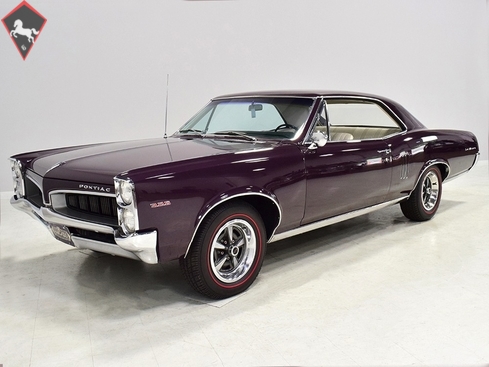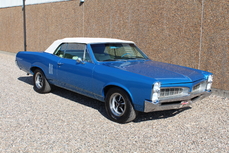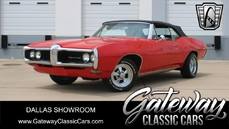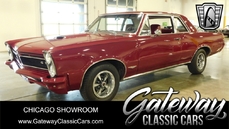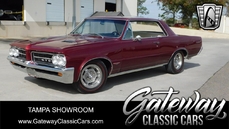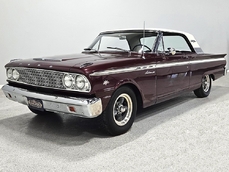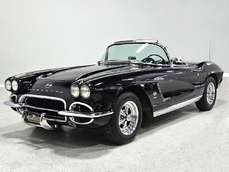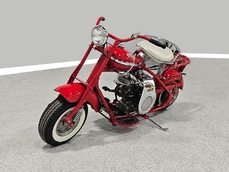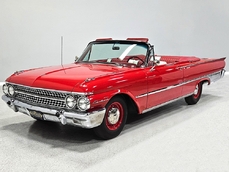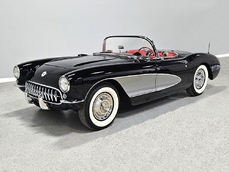Pontiac Le Mans 326 cubic inch V8 1967
General description :
It is unlikely that I will be able to impart to you through words and photos just how AMAZING this 1967 Pontiac Le Mans really is. You’ll probably dismiss it as “not-a-GTO” and “too expensive for not-a-GTO” and “I only want a real GTO” and things like that, which is completely missing the point. This car is as quick as a GTO (it has a strong-running 326 inside), it is rarer than a GTO (I promise you will not see another one at any show you attend), it’s still cheaper than a GTO, and it flat-out works better than any GTO I’ve ever driven. It has just 18,114 ORIGINAL MILES and yes, that’s original code M Plum Mist paint and the original Parchment interior. It is tight, smooth, quiet, and solid in a way that you may not have experienced before. It makes people stop and gawk at its remarkable preservation. The color is unusual but there’s enough testosterone in this car that you can drive it proudly without worrying about your buddies chiding you for not buying the red one. It is flat-out one of the finest cars I’ve ever driven and one of the coolest cars we’ve ever had in inventory. This is not sales pitch, not hyperbole; I’m just trying to get through the “not-a-GTO” haze that’s hanging over you right this moment and tell you that this car will delight you like no other. If quality matters more to you than a brand-name, read on!
The thing that’s truly special about this Le Mans is the level of preservation. It spent a majority of its life in Arizona, coming to Ohio long after it had passed from daily driver to collector car, so it never saw rain and certainly not snow. We’ll also admit that it started life with a six-cylinder and a PowerGlide automatic, and while that probably isn’t lighting your pedigree fires, it does mean that the car was never hammered or abused—with only 18,114 original miles, it was the proverbial little old lady special. That is unquestionably factory-applied code M Plum Mist paint on the bodywork, front to back, top to bottom. No touch-ups, no repaired dents, zero nonsense. It shines up the way only vintage paint can and yes, while there is some very, very minor checking and micro-blistering on the hood, you need to get your nose about six inches away in just the right light to see it. We could hardly even photograph it, no matter how hard we tried (you can see it in the photo showing the nose emblem on the hood). Original paint means no nonsense underneath, so you won’t take it to your body shop and have the manager take you aside and show you the mess he’s found underneath (however, he will very likely take you aside and ask where you found a car this clean). The doors, hood, and trunk fit just the way the factory did it—which is pretty darned nice—and all the weather seals are still supple so everything locks up tight. No squeaks, no rattles, no drafts. You just can’t restore this kind of solid feel back into a car, I don’t care how good your shop is.
Likewise, all the chrome, the emblems, the glass, and the lenses are original and in nearly new condition. No stone chips in the windshield, no pitting in the chrome, no fading in the taillights, and it even carries four original T3 headlights up front. The guy who installed the ‘326’ emblems on the front fenders intended for the car to look as much like an original 326 Le Mans as possible, so they’re a nice addition and since the 326 block and the 400 block are visually identical, nobody’s going to know it didn’t come this way from the factory. And I have to admit that I like the Le Mans taillights better than the fluted GTO pieces—simple can sometimes be better and every time you drive it, people will do a double take because it doesn’t quite look right in a world filled with garden-variety GTOs. Sometimes standing out doesn’t mean spending more money.
The code 224-B Parchment bucket seat interior is also entirely original. You can spot factory upholstery by the depth of the pleats—compare this Le Mans to any high-dollar restored GTO and I promise these seats will look better. Deeper pleats, heavier materials, and exactly the right color (most of the repro stuff is too metallic). The black carpets and dash pad are original, too, showcasing the low mileage and the care it has received. Heck, even the original seat belts look new and remain totally smooth and flexible, not faded and stiff. The steering column was changed out when the engine and transmission were swapped, so there’s no stub of a PowerGlide shifter hanging off to give things away, and the Hurst cue ball knob looks exactly right sticking out of the transmission tunnel. The original gauges only cover the basics of speed and fuel level, but that’s’ how it was delivered so that’s how they left it, and we’re thrilled that nobody added any aftermarket dials underneath. There’s just no need. The original AM radio still works and has an optional rear speaker with a switch on the dash—both speakers sound great. Heavy-duty floor mats were added at some point, and that’s just a good idea, while the back seat looks like it hasn’t hosted a guest since 1969. Even the headliner is clean, taut, and bright. In back, the trunk is completely rust-free, showing factory spatter paint, the original trunk mat (a little brittle but quite nice) and the original spare tire and jack assembly. Yep, that’s a 1967 Firestone bias-ply whitewall. And please note that the original jack instructions are still under the deck lid and there are no tell-tale masking marks around them.
Yes, the car was originally fitted with a simple 215 cubic inch inline-6, but I’m not sure this car would be so special with it still under the hood. Instead, the second owner found a correct WR-coded 1967 326 cubic inch HO V8, rebuilt it, and slid it under the hood. Obviously it was an easy bolt-in, along with the upgraded Muncie 4-speed manual gearbox, because you could have ordered it that way from the factory. It looks and acts completely stock, with proper Pontiac Turquoise engine enamel, reproduction tower hose clamps, and a factory-style Carter 4-barrel carburetor on top. They added GTO-spec chrome valve covers and a matching air cleaner, but I think if this were my car, I’d take it back to 100% stock spec with OEM parts—your call. All the factory-style linkages and tubing are in place, there’s a thick radiator up front, and correct cast iron exhaust manifolds handle the fumes. Check out how clean the inner fenders are, the original Plum Mist overspray on the firewall, and the condition of the underside of the hood. If I hadn’t told you this car came with a six, you would never, ever know.
The original PowerGlide was tossed in favor of a familiar Muncie 4-speed manual transmission and there’s a GM 10-bolt with 3.90 gears on a limited slip, so this sucker is extremely punchy around town. Clutch take-up is easy, shifts are crisp, and the sucker pulls like a freight train in all four gears—do NOT underestimate that 326! The suspension is supple, the brakes are effective, the steering tracks like a cruise missile, all things that you get with an original car but which are very, very difficult to restore back into a high-mileage machine. It feels like every joint is lined with silk. Bumps are a distant “thump-thump” and even thought the steering is unassisted, you won’t have any problems with it—the only reason everyone thinks they NEED power steering is because they’re used to dealing with worn-out steering gear. Your mother could handle this car without issues, I promise. New shocks help with the smooth ride and there’s an OEM-style dual exhaust system that sounds just about right—not too aggressive but not invisible, either. Obviously rust is a non-issue, although there’s the usual surface scale on the heavy metal parts like the driveshaft and rear suspension. None of it matters and the floors are immaculate. Factory Rally II wheels were on the car when it was new, and they remain in place and now carry fresh 205/75/14 Diamondback redline radials.
If you’ve read this far, you understand how much we love this car. But do you really understand how special it truly is? When I took my usual 3-mile test drive in this car, I didn’t want it to end. I wanted to burn a whole tank of gas and then keep on going. This Pontiac works so well that it will make any other car you test drive feel sloppy and old, so please come see it last if you have a list. There’s a feeling to unrestored, original, low-mileage cars that can’t be replicated and even if you were there in 1967, I bet you’ve long since forgotten how good these cars could be. Yes, your price guide says our asking price is too much, I know, I know. But how do you quantify a car with so few miles in such cool colors that’s so wonderful to drive? Even at this price, it’s still cheaper than a GTO, I’ll wager that it’s faster, it drives better, and if standing out matters, this Le Mans totally nails it.
The only question remains: are you a visionary or are you just part of the herd? If you’re a visionary, you should call today!
http://www.harwoodmotors.com/vehicles/inventory_details.php?id=969
1967 Pontiac Le Mans 326 cubic inch V8 is listed sold on ClassicDigest in Macedonia by for $34900.
Car Facts
Car type : Car Make : Pontiac Model : Le Mans Model Version : 326 cubic inch V8 Engine size : 0.0 Model Year : 1967 Sub type : Coupé Location : Ohio
Sold
Seller Information
Sold
People who viewed this Pontiac Le Mans also viewed similar Pontiac listed at ClassicDigest
Other cars listed for sale by this dealer
About Pontiac
Pontiac, a division of General Motors (GM), held a distinctive position within the company's hierarchy and played a significant role in automotive history. Here's an overview of Pontiac's history and some of its most iconic models up to the 1980s:Position in GM Hierarchy:
Distinct Identity: Pontiac occupied a unique place within GM, known for its performance-oriented vehicles and youthful branding.
Mid-Level Brand: Positioned above Chevrolet but below the more upscale divisions such as Oldsmobile, Buick, and Cadillac, Pontiac aimed to offer affordable yet sporty cars.
History and Notable Models:
Pontiac GTO (1964-1974):
Iconic Muscle Car: Considered the first true American muscle car, blending performance and style.
Specifications: V8 engines, powerful performance, and aggressive styling made the GTO immensely popular.
Pontiac Firebird (1967-1981):
Muscle Car and Pony Car: Shared the platform with the Chevrolet Camaro, featuring distinct Pontiac styling cues.
Variants: Offered various models and engine options, including the Trans Am, which gained fame through movies like "Smokey and the Bandit."
Pontiac Grand Prix (1962-2008):
Personal Luxury Car: Initially a full-size car, later transformed into a mid-size model, known for its blend of comfort and performance.
Evolution: Over the years, it transitioned from a performance-oriented car to a more luxurious offering.
Pontiac Bonneville (1957-2005):
Flagship Model: Started as a full-size car, evolving into a luxurious and technologically advanced vehicle.
Innovation: Known for introducing features like fuel injection, making it a symbol of Pontiac's technological advancements.
Impact and Legacy:
Performance Image: Pontiac carved a niche for itself by emphasizing performance, sportiness, and innovation, attracting younger and enthusiast drivers.
Marketing Success: Innovative marketing strategies and successful racing endeavors contributed to Pontiac's popularity and brand image.
Cessation of Production: Unfortunately, due to financial constraints and changes in consumer preferences, GM discontinued the Pontiac brand in 2010, marking the end of its legacy in the automotive industry.
